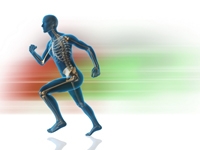If there were a drug — let's call it the "success drug" — that, while illegal, guaranteed professional success, money and fame, no harmful side effects, as well as the knowledge that there was no chance of being caught taking it, would you take it?
When Dr. Ronald G. Crystal, the Bruce Webster Professor of Internal Medicine and chairman of the Department of Genetic Medicine at Weill Cornell Medical College, presented this question to his Grand Rounds audience in Uris Auditorium on April 16, the majority in attendance couldn't raise their hands fast enough.

Dr. Crystal then added a caveat to his question.
"What if, in five years, the drug would kill you?"
And then, not so many hands.
But many athletes, presented with this same scenario, are often quick to take that deal with the devil and ingest dangerous and illegal substances that may fulfill their dreams of athletic glory, but could also kill them in the process. And since so many of these drugs are procured and taken in secret, hard data to either support or refute their effectiveness is seriously lacking.
One of the few substances that have performed well, at least by the metric of athletic achievements, is anabolic steroids. Marita Koch, an East German track star from the late '60s to late '80s, collected more than 30 world records throughout her career. While Koch never admitted to using the steroid turinabol, documents later showed that it was an integral part of her training.
Because of the physiological makeup of women, Dr. Crystal said, the effects of anabolic steroids — increased strength, size, and sprinting and recovery speed — are even more profound. Of course, the negative impact of anabolic steroids, including liver damage, depression, aggression, infertility in women and impotence in men, can also be quite damaging.
Other steroids, such as human growth hormone and androstenedione — a chemical that enhances the body's production of testosterone — are backed by little to no data that suggests increased performance.
"These drugs get widely publicized and there is an automatic assumption that they work," Dr. Crystal said.
Ephedra, a stimulant that was popular in weight lifting and collision sports, also showed no performance-enhancing properties. But a rash of seizures and sudden death by it among users prompted it to be pulled from the shelves in 2004.
Not all performance-enhancing drugs are used to gain bulk and raw power. Anxiolytics are taken by golfers, ski jumpers and Olympic shooters to mask the effects of anxiety and to suppress minor hand tremors. Oxygen-boosting drugs are popular with cyclists and endurance athletes as they increase red blood cells. They can also lead to strokes and pulmonary emboli.
But taking drugs or pills that may or may not enhance strength and performance is already an antiquated form of cheating for some. The new dawn of performance enhancement lies in genetic doping, where genes associated with specific skills and strengths are transferred to a person's DNA.
Right now, the testing technology lags far behind the science of the drugs themselves. With genetic doping, testing will be almost useless, said Dr. Crystal. "These are natural genes — human genes — which are functioning exactly like other genes," he said. "They cannot be detected."
As the lengths athletes will go for glory and achievement continue to defy sound medical wisdom, Dr. Crystal urges all physicians to be wary when it comes to performance-enhancing substances and their patients.
"This area is different from other areas of medicine because it's done surreptitiously," Dr. Crystal said. "The patients are not going to tell you they are using these drugs, but it's something we need to be aware of."

